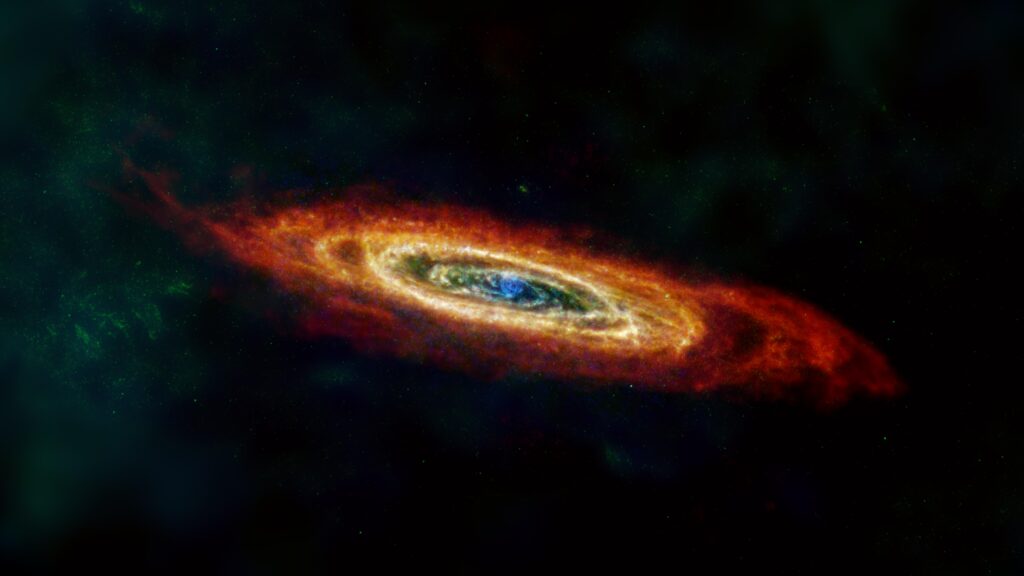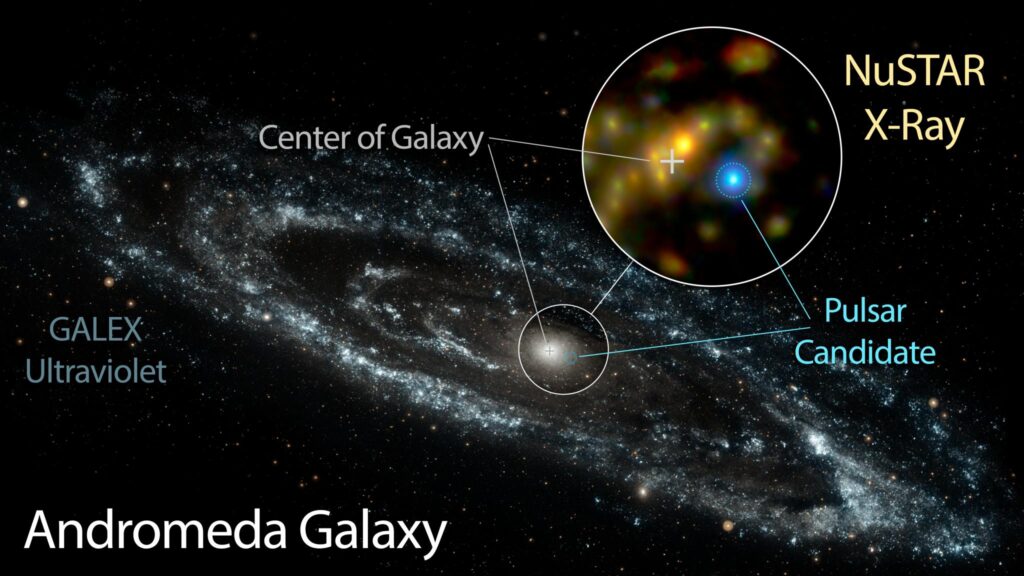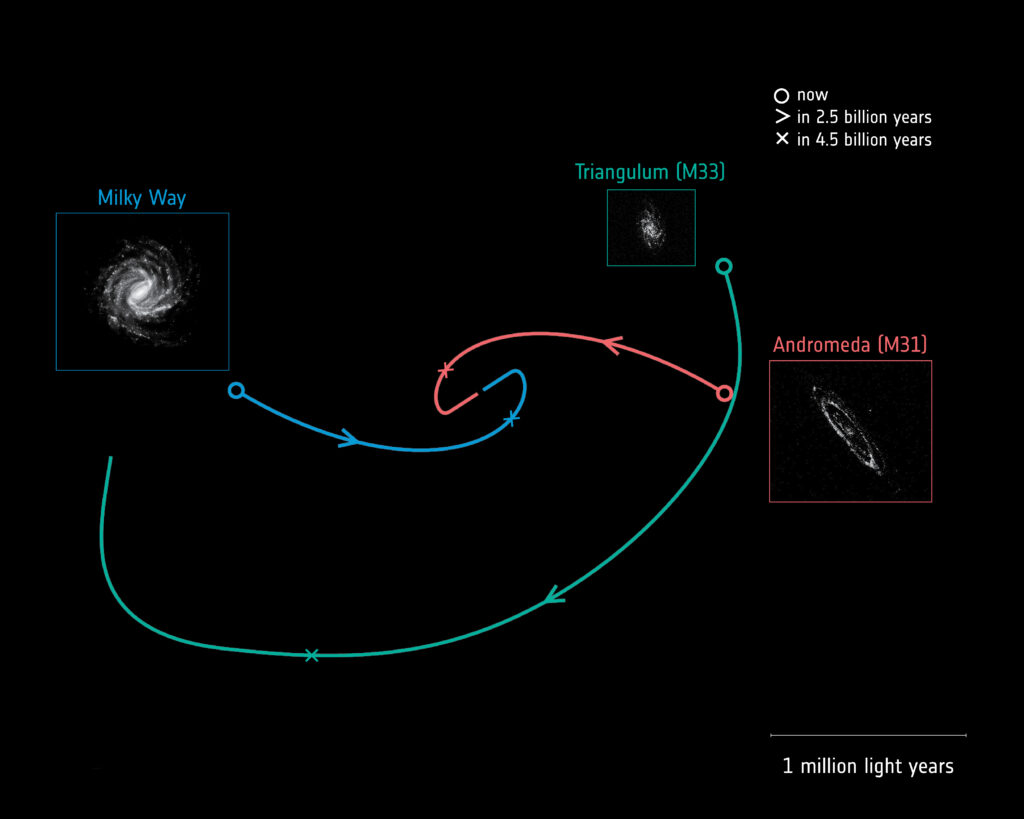Milky Way’s Celestial Dance Partner
© NASA/JPL-Caltech
Andromeda Galaxy, a majestic spiral galaxy which has a diameter of about 46.56 kiloparsecs and is located approximately 2.537 million light-years away from Earth. It was originally named the Andromeda Nebula and is catalogued as Messier 31, M31, and NGC 224. Initially designated as the Andromeda Nebula, it is logged under various catalogue numbers: Messier 31, M31, and NGC 224. Its nomenclature is derived from its location in the Earth’s sky within the constellation of Andromeda. It wasn’t until the 1920s that American astronomer Edwin Powell Hubble definitively established that Andromeda constituted a distinct galaxy beyond the bounds of the Milky Way.
The Andromeda Galaxy’s history is marked by encounters with and absorption of other galaxies. Its distinctive nearby companion, M32, displays characteristics suggesting it was once a conventional, more substantial galaxy that shed much of its outer components, potentially including all of its globular clusters, during a previous interaction with M31. In-depth surveys of the outer reaches of the Andromeda Galaxy have unveiled extensive, cohesive formations of star streams and clouds. These possess attributes indicating they encompass the outer remnants of smaller galaxies assimilated by the central behemoth, alongside clusters of M31 stars expelled due to the potent tidal forces generated by the collision.
The Andromeda Galaxy boasts a virial mass on par with the Milky Way, approximately 1 trillion solar masses (equivalent to 2.0×1042 kilograms). Accurately estimating the mass of either galaxy proves challenging, but conventionally, it was believed that the Andromeda Galaxy outweighed the Milky Way, potentially by a margin of 25% to 50%.
Projections indicate that the Milky Way and Andromeda galaxies are on a collision course, slated to converge in approximately 4–5 billion years. This merger could give rise to a colossal elliptical or a sizable lenticular galaxy. Andromeda’s luminosity, with an apparent magnitude of 3.4, ranks it among the brightest in the Messier catalogue. It is discernible to the unaided eye from Earth during moonless nights, even from locales affected by moderate light pollution.
FORMATION OF ANDROMEDA GALAXY

The formation of the Andromeda Galaxy is believed to be a complex interplay of cosmic processes that unfolded over billions of years. Here’s a detailed explanation of the formation of the Andromeda Galaxy:
- Protogalactic Cloud: Around 13 billion years ago, the universe was a hot, dense, and uniform soup of subatomic particles. Within this primordial mix, slight density fluctuations led to the formation of denser regions called protogalactic clouds.
- Dark Matter Halo: These protogalactic clouds started to collapse under the influence of gravity. Simultaneously, surrounding dark matter, which doesn’t emit, absorb, or reflect light, exerted its gravitational pull, creating a “halo” of unseen mass around the forming galaxy.
- Star Formation: As the cloud collapsed, it fragmented into smaller clumps, each of which would eventually give rise to stars. These newborn stars emitted intense radiation, illuminating the surrounding gas clouds and heating them.
- Disk Formation: The gravitational forces acting on the system caused the majority of material to collect at the center, forming a dense, rotating core. Around this core, a flat, rotating disk of gas, dust, and stars began to take shape.
- Spiral Structure: Density waves within the disk led to the development of spiral arms. These regions of higher density are conducive to star formation and are the characteristic features of spiral galaxies like Andromeda.
- Mergers and Interactions: Over billions of years, Andromeda likely experienced interactions with other galaxies. This includes small satellite galaxies that merged with Andromeda or passed close by, influencing its structure.
There was a possibility of a very close encounter between Andromeda and the Triangulum Galaxy (M33) around 2–4 billion years ago. However, recent measurements from the Hubble Space Telescope suggest that this event is improbable.
STRUCTURE

In terms of its visible light characteristics, the Andromeda Galaxy falls under the classification of an SA(s)b galaxy in the extended de Vaucouleurs–Sandage system for categorizing spiral galaxies. Nevertheless, data gathered from the 2MASS survey and the Spitzer Space Telescope in the infrared spectrum has revealed that Andromeda is, in fact, a barred spiral galaxy similar to the Milky Way. Notably, the major axis of Andromeda’s bar is positioned at an angle of 55 degrees in an anti-clockwise direction from the major axis of its disc.
CENTRAL BULGE
The central bulge of the Andromeda Galaxy is a dense, spherical core at its center. It is primarily composed of older stars that have likely existed for billions of years, contributing to the galaxy’s stability. Stellar interactions and gravitational forces are intense in this region due to the close proximity of stars, potentially leading to phenomena like stellar collisions or binary star system formations. These older stars tend to have a reddish hue, indicating their advanced age.
The central bulge is not only inhabited by stars but also contains interstellar gas and dust. These materials provide the raw ingredients for future star formation. In regions with higher concentrations, new stars can form, enriching the central bulge’s diverse stellar population. This core region plays a crucial role in shaping the Andromeda Galaxy’s overall structure and behaviour, exemplifying the complex interplay of astrophysical processes over billions of years.
The nucleus of the Andromeda Galaxy is the central region at its heart. It hosts a high concentration of stars, contributing to its brightness. This core is a hub of stellar activity, likely containing a supermassive black hole, although not directly observable. The nucleus influences the dynamics of the galaxy, impacting the orbits and motions of stars and gas in its vicinity. It plays a pivotal role in regulating the galactic center’s behaviour and is a key element in understanding the overall structure and functioning of the Andromeda Galaxy.
The Andromeda Galaxy harbours a supermassive black hole at its center, estimated to be around 140 million times the mass of the Sun. This colossal entity exerts a profound gravitational influence on its surroundings, impacting the motions of stars and gas near the galactic nucleus. While not directly observable, scientists infer its presence through studies of stellar orbits and radiation emitted by interacting material. This supermassive black hole plays a crucial role in regulating the dynamics of the galactic core, exemplifying the complex interplay between black holes and their galactic environments.
SPIRAL ARMS
The spiral arms of the Andromeda Galaxy are a defining feature of its structure, contributing to its majestic appearance. These sprawling, curving lanes of stars, gas, and dust extend outward from the central bulge, forming a distinct pattern that characterizes many spiral galaxies.
In the Andromeda Galaxy, these spiral arms are regions of intense stellar activity. They are home to a vibrant population of young, massive stars, often referred to as “OB stars.” These hot, luminous stars emit copious amounts of energy, illuminating the surrounding space and casting a brilliant glow on the arms. It is the presence of these youthful stars that imbues the spiral arms with their characteristic blue colouration.
One of the primary driving forces behind the formation of spiral arms is the phenomenon known as density waves. These are not actual physical waves, but rather regions within the galactic disk where the density of stars, gas, and dust is higher. As the galaxy rotates, these density waves move more slowly than the stars, causing matter to accumulate in certain regions.
In these denser regions, the gravitational pull is stronger, leading to the formation of new stars. The process begins with the compression of interstellar gas and dust due to the increased density. This compression triggers the collapse of these materials, giving rise to the birth of young stars. Over time, these stars contribute to the brilliance of the spiral arms, while also enriching them with elements forged in their nuclear furnaces.
Furthermore, the spiral arms serve as cosmic nurseries, fostering the creation of star clusters and stellar associations. These groupings of stars share a common origin and often remain gravitationally bound to one another. As they age, they disperse throughout the galaxy, becoming an integral part of its overall stellar population.
In addition to stars, the spiral arms of Andromeda also host vast clouds of interstellar gas and dust. These nebular regions, known as H II regions, are characterized by ionized hydrogen gas, a telltale sign of recent or ongoing star formation. These regions are illuminated by the intense ultraviolet radiation emitted by the young, hot stars.
DISK
The disk of the Andromeda Galaxy is a sprawling, flat expanse that surrounds its central bulge. This disk is a critical component of the galaxy’s overall structure, comprising a vast collection of stars, gas, and dust that extends for tens of thousands of light-years. It is within this disk that much of the galaxy’s dynamic activity and stellar processes take place.
The stars within the disk exhibit a wide range of characteristics, including varying ages, masses, and chemical compositions. Near the center of the disk, where conditions are denser, older stars tend to dominate. These stars have likely been part of the Andromeda Galaxy for billions of years, contributing to the galaxy’s overall stability.
Moving outwards from the center, the population of stars becomes more diverse. Younger stars, often characterized by their blue colouration, are concentrated in regions of the disk known as spiral arms. These arms are regions of enhanced star formation, driven by the compression of interstellar gas and dust within density waves. In these areas, the densest pockets of material serve as stellar nurseries, giving rise to the birth of new stars.
Interstellar gas and dust play a crucial role in the life cycle of the disk. These materials serve as the raw building blocks for star formation. Within dense regions of the disk, interstellar gas becomes compressed, leading to the formation of molecular clouds. These clouds are the birthplaces of stars, as they provide the necessary conditions for gravitational collapse and subsequent star formation.
Moreover, the disk of the Andromeda Galaxy is not static. It undergoes continuous rotation around the galactic center, with stars and gas particles orbiting at varying speeds depending on their distance from the center. This rotational motion creates a sense of dynamism within the disk, influencing the orbits and interactions of its cosmic constituents.
The disk also hosts a rich variety of celestial objects, including open star clusters, planetary nebulae, and supernova remnants. These objects are testaments to the complex and dynamic processes that have shaped the disk over billions of years.
HALO
The halo of the Andromeda Galaxy is a vast, spherical region surrounding its central bulge, disk, and spiral arms. This component is characterized by a sparse distribution of stars, interstellar gas, and dust, extending far beyond the denser, central regions of the galaxy.
Within the halo, stars are relatively thinly dispersed compared to the more crowded regions closer to the galactic center. These stars are typically older and have lower metallicity, indicating they formed in an earlier epoch when heavy elements were less abundant in the cosmos. This suggests that they have likely been part of the Andromeda Galaxy since its early stages.
Additionally, the halo is thought to host a diverse population of stellar objects, including globular clusters. These are tightly bound groups of stars that orbit around the galaxy. They are found in various regions of the galaxy, including the halo. Globular clusters contain stars of different ages and compositions, offering insights into different stages of the galaxy’s evolution.
The halo also contains interstellar gas and dust, although at lower densities compared to regions within the disk or central bulge. While the gas and dust content is sparse, it still plays a role in ongoing processes like star formation, albeit at a slower rate compared to denser regions.
The halo’s connection with dark matter is a particularly captivating facet. This enigmatic substance, devoid of any light emissions, absorption, or reflection, exerts a gravitational pull. It’s thought to constitute a substantial portion of the universe’s mass. Although dark matter remains unobservable directly, its existence is deduced from its gravitational impact on observable matter.
GALACTIC NEIGHBOURHOOD

The Andromeda Galaxy is a member of the Local Group, a small cluster of galaxies that are gravitationally bound together. Within this group, there are several galactic neighbours of the Andromeda Galaxy.
MILKY WAY GALAXY
Our Solar System resides in the Milky Way, also referred to as the Galaxy. Structurally, it shares similarities with the Andromeda Galaxy, featuring a barred spiral configuration.
CHARACTERISTICS
- Size and Morphology: The Milky Way has a diameter of about 100,000 light-years, making it slightly smaller than Andromeda. It has a central bulge, spiral arms, and a prominent bar in its core.
- Structure: The Milky Way has a central bar, a galactic disk, and spiral arms. It is part of a binary system with the Andromeda Galaxy, meaning they orbit a common center of mass.
- Star Formation: Like Andromeda, the Milky Way has regions of active star formation, particularly in its spiral arms.
TRAINGULUM GALAXY
M33, commonly known as the Triangulum Galaxy, is a spiral galaxy positioned around 2.73 million light-years distant from Earth. Within the Local Group, it holds the distinction of being the third-largest galaxy.
CHARACTERISTICS
- Size and Morphology: M33 has a diameter of about 50,000 light-years, making it considerably smaller than both Andromeda and the Milky Way.
- Structure: It exhibits features characteristic of a spiral galaxy, including a central bulge, a galactic disk, and spiral arms.
- Star Formation: M33 is known for its active star-forming regions, containing numerous young, massive stars.
M32 AND M110
M32 and M110 are two of the satellite galaxies of the Andromeda Galaxy. They orbit around Andromeda and are influenced by its gravitational pull. M32 is a dwarf elliptical galaxy, while M110 is a dwarf spheroidal galaxy. They are considerably smaller than Andromeda and have different structural characteristics.
OTHER DWARF GALAXIES
The Local Group also contains a multitude of smaller, irregular, and dwarf galaxies. These include the 2 Magellanic Clouds: the Large Magellanic Cloud, the Small Magellanic Cloud, and numerous other smaller galaxies. They play a vital role in the dynamics of the Local Group.
ANDROMEDA VS MILKY WAY

| Milky Way | Andromeda Galaxy | |
| Type | Barred spiral galaxy | Spiral galaxy |
| Location | Located in the Local Group, a cluster of galaxies including the Andromeda Galaxy | Located approximately 2.5 million light-years away from the Milky Way |
| Size | Diameter of about 100,000 light-years | Diameter of about 120,000 light-years |
| Mass | Estimated to be about 1.5 trillion times the mass of the Sun | Estimated to be about 1.5 trillion times the mass of the Sun |
| Structure | Contains a central bulge and spiral arms | Contains a central bulge and spiral arms |
| Galactic Features | Houses the Sagittarius A* supermassive black hole at its center | Houses the M31 nucleus, a bright core region |
| Stellar Populations | Home to billions of stars, including a wide range of stellar populations | Home to billions of stars, including a wide range of stellar populations |
| Galaxy Interaction | Currently on a collision course with the Andromeda Galaxy, leading to a future merger | Currently on a collision course with the Milky Way, leading to a future merger |
| Observable Features | Visible as a band of light across the night sky | Visible as a distinct fuzzy patch in the constellation of Andromeda |
| Historical Significance | Served as the point of reference for early astronomers to understand our place in the universe | First spiral galaxy observed beyond our own, providing insights into galactic structures |
COLLISION OF ANDROMEDA AND MILKY WAY

The Andromeda galaxy, the closest spiral galaxy to our Milky Way, is usually inconspicuous in our night sky, requiring a deliberate search. Yet, under truly dark skies, it may be discernible to the naked eye, albeit as a faint, hazy glow. Nevertheless, in the distant future, Andromeda will become increasingly prominent in our celestial panorama, expanding in size and brilliance as it approaches our galaxy. Despite the current separation of 2.5 million light-years, the process of merging our two galaxies has, indeed, already commenced.
The impending collision of the Andromeda Galaxy (M31) and our Milky Way is a cosmic event of unparalleled scale and significance. These two colossal galaxies, each containing billions of stars, are hurtling through the universe, drawn together by the force of gravity.
When this cosmic rendezvous occurs in about 4.5 billion years, the result will be a spectacular celestial dance. The gravitational forces at play will distort and stretch the shapes of both galaxies, their spiral arms becoming intertwined in an intricate ballet of stars, gas, and dust.
Though the densities of stars are incredibly high within galaxies, the vast distances between individual stars mean that direct stellar collisions are highly improbable. Instead, stars will pass by one another, their immense gravitational fields gently altering each other’s trajectories.
As the cores of the Milky Way and Andromeda draw nearer, they will eventually merge, forming a new, hybrid galaxy. This entity, sometimes referred to as “Milkomeda” or “Milkdromeda,” will combine elements from both original galaxies, giving rise to a unique cosmic entity.
This merging process will be accompanied by colossal upheavals, triggering waves of star formation and rearranging the distribution of matter. The night sky, as observed from within this newly formed galaxy, will be dramatically altered, offering a breathtaking display of celestial wonders.
Throughout this cosmic transformation, our Solar System, which was once a relatively isolated entity within the Milky Way, will become part of this newly formed galactic community. The night sky will be adorned with stars and celestial phenomena from both ancestral galaxies, offering a visual testament to the profound merger that reshaped the cosmic landscape.
